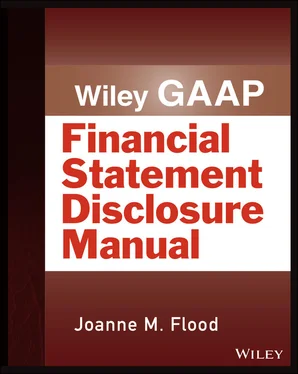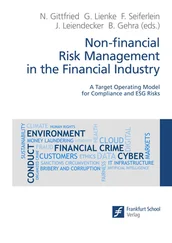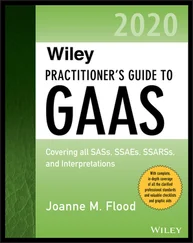The Company does not believe other recently issued but not yet effective accounting standards, if currently adopted, would have a material effect on the Company's consolidated financial statements.
Example 7.48: Recent Accounting PronouncementsIn February 2016, the FASB issued ASU 2016‐02, Leases (Topic 842) . ASU 2016‐02 requires lessees to recognize lease assets and lease liabilities on the balance sheet and requires expanded disclosures about leasing arrangements. ASU 2016‐02 is effective for fiscal years beginning after December 15, 2020, for nonpublic business entities, with early adoption permitted. The Company is in the process of evaluating the impact of this ASU on its financial statements.
Management does not believe that any recently issued, but not yet effective, accounting standards could have a material effect on the accompanying financial statements. As new accounting pronouncements are issued, we will adopt those that are applicable under the circumstances.
Example 7.49: Recently Adopted Accounting PronouncementsIn May 2014, the Financial Accounting Standards Board (“FASB”) issued Accounting Standards Update (“ASU”) 2014‐09, Revenue from Contracts with Customers (“ASC 606”), which supersedes the revenue recognition requirements in ASC 605, Revenue Recognition . This ASU requires that an entity recognize revenue to depict the transfer of promised goods or services to customers in an amount that reflects the consideration to which the entity expects to be entitled in exchange for those goods or services.
The Company adopted ASC 606 on January 29, 2018, on a modified retrospective basis. There were no changes to the consolidated statement of operations as a result of the adoption, and the timing and amount of its revenue recognition remained substantially unchanged under this new guidance. Under the provisions of ASC 606, the Company is now required to present its provision for sales returns on a gross basis, rather than a net basis. The Company's liability for sales return refunds is recognized within other current liabilities, and the Company now presents an asset for the value of inventory which is expected to be returned within other prepaid expenses and other current assets on the consolidated balance sheets. Under the modified retrospective approach, the comparative prior period information has not been restated for this change.
The effect of adoption of ASC 606 on the Company's consolidated balance sheet as of February 3, 2019, was as follows:
|
As Reported |
Adjustment for ASC 606 |
Balances without Adoption of ASC 606 |
| Other prepaid expenses and other current assets |
$57,949 |
$(3,719) |
$54,230 |
| Current assets |
1,429,282 |
(3,719) |
1,425,563 |
| Total assets |
2,084,711 |
(3,719) |
2,080,992 |
| Other current liabilities |
112,698 |
3,719 |
116,417 |
| Current liabilities |
500,477 |
3,719 |
504,196 |
| Total liabilities |
638,736 |
3,719 |
642,455 |
In May 2017, the FASB amended ASC 718, Stock Compensation , to reduce diversity in practice and to clarify when a change to the terms or conditions of a share‐based payment award must be accounted for as a modification and will result in fewer changes to the terms of an award being accounted for as modifications. The new guidance was effective beginning in the first quarter of fiscal 2018 and will apply on a prospective basis. The adoption does not have a material impact on the Company's consolidated financial statements.
In January 2018, the FASB released guidance on the accounting for the global intangible low‐taxed income (“GILTI”) provisions of the tax bill H.R.1, commonly known as the U.S. Tax Cuts and Jobs Act (“U.S. tax reform”). The GILTI provisions impose a tax on foreign subsidiary earnings in excess of a deemed return on the foreign subsidiary's tangible assets. The Company has made an accounting policy election to treat the GILTI tax as an in period tax, which is consistent with the treatment prior to the accounting policy election.
In February 2018, the FASB amended ASC 220, Income Statement—Reporting Comprehensive Income . ASC 740, Income Taxes , requires that the effect of a change in tax laws or rates on deferred tax assets and liabilities be included in income from continuing operations. In situations in which the tax effects of a transaction were initially recognized directly in other comprehensive income, this results in “stranded” amounts in accumulated other comprehensive income related to the income tax rate differential. The amendments to ASC 220 allow a reclassification from accumulated other comprehensive income to retained earnings for stranded tax effects resulting from the enactment of U.S. tax reform. As permitted by the ASU the Company early adopted the amendments to ASC 220, and made the policy election to not reclassify “stranded” amounts from accumulated other comprehensive income to retained earnings.
Example 7.50: Recently Issued Adopted PronouncementsIn February 2016, the FASB issued ASC 842, Leases (“ASC 842”) to increase transparency and comparability among organizations by recognizing lease assets and lease liabilities on the balance sheet and disclosing key information about leasing arrangements. Under the new guidance, lessees are required to recognize a lease liability, which represents the discounted obligation to make future minimum lease payments, and a corresponding right‐of‐use asset on the balance sheet. This guidance is effective for the Company beginning in its first quarter of fiscal 2019. The new guidance can be applied using a modified retrospective approach at the beginning of the earliest period presented, or at the beginning of the period in which it is adopted.
The Company adopted ASC 842 on February 4, 2019 using the modified retrospective approach and will not be restating comparative periods.
The Company has chosen to apply the transition package of three practical expedients that allow companies not to reassess whether agreements contain leases, the classification of leases, and the capitalization of initial direct costs. The Company has also made an accounting policy election to recognize lease expense for leases with a term of 12 months or less on a straight‐line basis over the lease term and will not recognize any right of use assets or lease liabilities for those leases.
The Company has completed the implementation of new lease accounting software, and updated its internal controls to address the requirements of the new standard.
The primary financial statement impact upon adoption will be the recognition, on a discounted basis, of the Company's minimum commitments under noncancellable operating leases as right of use assets and obligations on the consolidated balance sheets. The adoption of ASC 842 results in the recognition of lease‐related assets and liabilities of approximately $620.0 million and $650.0 million, respectively. Preexisting net lease‐related assets and liabilities of approximately $30.0 million have been reclassified as part of the adoption of the new standard, and there is no adjustment to opening retained earnings. The standard is not expected to have a material impact on the Company's net income or cash flows.
Example 7.51: Risks and UncertaintiesThe Company's business, financial position, and results of operations may be influenced by the political, economic, and legal environments in the People's Republic of China (PRC), as well as by the general state of the PRC economy. The Company's operations in the PRC are subject to special considerations and significant risks not typically associated with companies in North America and Western Europe. These include risks associated with, among others, the political, economic and legal environment and foreign currency exchange. The Company's results may be adversely affected by changes in the political, regulatory and social conditions in the PRC, and by changes in governmental policies or interpretations with respect to laws and regulations, anti‐inflationary measures, currency conversion, remittances abroad, and rates and methods of taxation, among other things. Moreover, the Company's ability to grow its business and maintain its profitability could be negatively affected by the nature and extent of services provided to its major customers, Guangzhou Investment Group Co., and Maoming Northwest Mining Co.
Читать дальше












